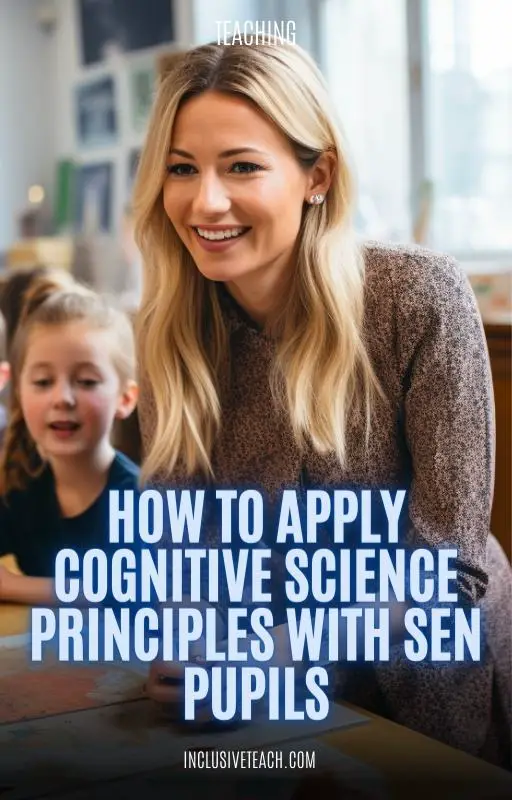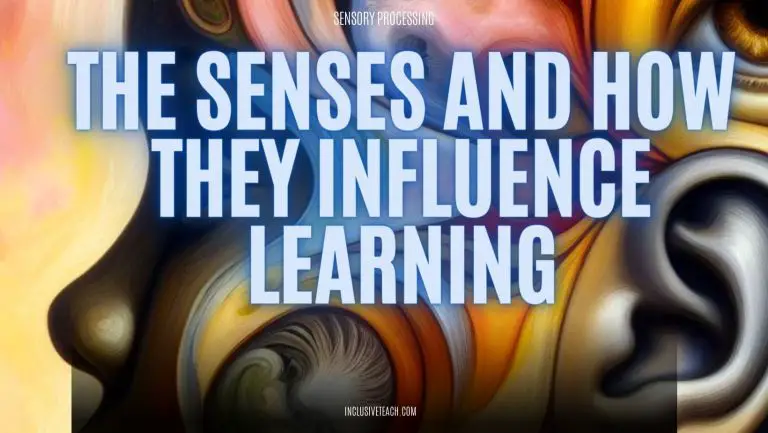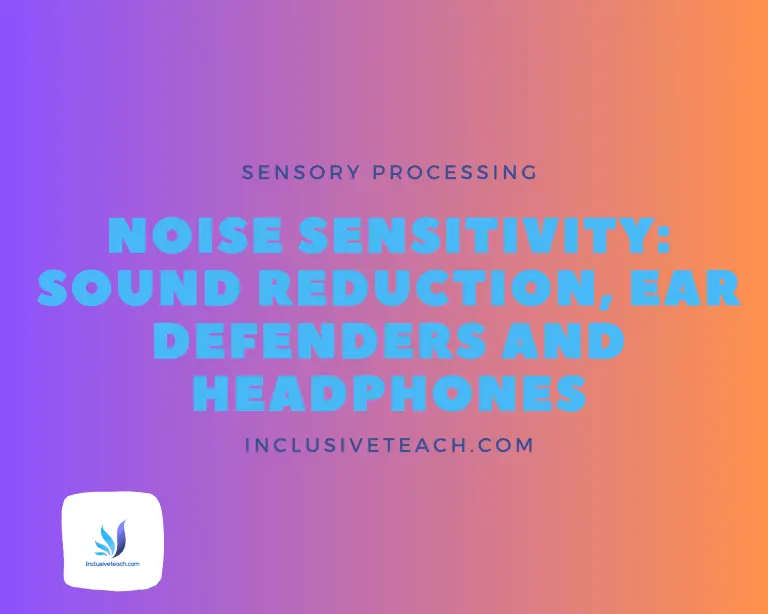How to Apply Cognitive Science Principles with SEN Pupils
Introduction to Cognitive Science and SEN
Cognitive science is the interdisciplinary study of how the mind works, drawing on insights from psychology, neuroscience, education, and other fields. It investigates the mental processes and structures that underlie human cognition, such as memory, perception, attention, reasoning, problem-solving, and language. By understanding how the mind works, cognitive science can help teachers design effective instruction that is aligned with how pupils learn, remember, and apply knowledge.
One of the main challenges of teaching is to meet the diverse needs and interests of pupils, especially those with special educational needs (SEN). SEN pupils are those who have a learning difficulty or disability that requires an element of adaptive teaching or additional support. They may face barriers to learning due to physical, sensory, cognitive, emotional, or behavioural difficulties, or a combination of these. Teachers need to provide inclusive, adapted, and engaging instruction that supports the learning and development of SEN pupils, while also ensuring that they have access to the same curriculum and opportunities as their peers.
The aim of this article is to discuss how teachers can apply the principles of cognitive science with SEN pupils in UK schools, using evidence-based strategies and subject-specific curricula and pedagogies. The paper will present the main aspects of cognitive science that are relevant for teaching and learning, and how they can be implemented in the classroom to enhance the quality and effectiveness of instruction for SEN pupils. The article will also provide examples of how cognitive science can inform the development of curricula and pedagogies for specific subjects, focusing on science as an illustrative domain.
Challenges and opportunities for teaching SEN pupils
Teaching SEN pupils poses a number of challenges and opportunities for teachers, as they need to balance the diverse needs and interests of their pupils with the demands and expectations of the curriculum and the school system. The tension between these demands is driving a lot of the stress in the post pandemic education system. Some of the main challenges and opportunities for teaching SEN pupils are :
- Diversity of needs: SEN pupils have a wide range of learning difficulties and disabilities, which may affect their cognitive, physical, sensory, emotional, or behavioural development. Teachers need to identify and understand the specific needs of each pupil, and provide appropriate support and intervention. This may require collaboration with other professionals, such as SENCOs, educational psychologists, speech and language therapists, and occupational therapists.
- Inclusion: SEN pupils have the right to be included in mainstream education, and to have access to the same curriculum and opportunities as their peers. Teachers need to create an inclusive learning environment, where SEN pupils feel valued, respected, and supported. This may involve adapting the curriculum, the teaching methods, the classroom organisation, and the assessment practices to suit the needs and abilities of SEN pupils.
- Differentiation: SEN pupils have different levels of prior knowledge, skills, and understanding, and may learn at different rates and in different ways. Teachers need to differentiate their instruction, by providing different levels of challenge, support, and feedback for different pupils. This may involve using a variety of teaching strategies, such as scaffolding, explicit instruction, cooperative learning, and personalised learning.
- Assessment: SEN pupils need to be assessed fairly and accurately, and to receive meaningful feedback on their learning progress and outcomes. Teachers need to use a range of assessment methods, such as observation, questioning, self-assessment, and peer-assessment, and to adjust the assessment criteria and standards to reflect the individual goals and achievements of SEN pupils. Teachers also need to use assessment data to inform their planning and instruction, and to monitor and evaluate the impact of their interventions.
- Engagement: SEN pupils need to be motivated and interested in their learning, and to have a positive attitude and self-confidence. Teachers need to engage SEN pupils in their learning, by making it relevant, meaningful, and enjoyable – demonstrating the value. This may involve using topics and activities that appeal to the interests and preferences of SEN pupils, and that peek their curiosity, creativity, and collaboration.
Aspects of cognitive science for teaching and learning
Cognitive science can provide teachers with a framework for understanding how pupils learn, remember, and apply knowledge, and how to design effective instruction that is aligned with how the mind works. The EEF has summarised seven aspects of cognitive science that are relevant for teaching and learning:
- Spaced learning (or distributed practice): This is the principle that learning is more effective when it is spread out over time, rather than crammed into a single session. This allows the memory to consolidate and strengthen over time, and reduces the risk of forgetting. Teachers can implement spaced learning by revisiting and reviewing previous topics at regular intervals, and by spacing out homework and revision sessions.
- Interleaving practice: This is the principle that learning is more effective when different topics or skills are mixed together, rather than practised in isolation. This helps pupils to make connections and comparisons between different concepts, and to transfer and apply their knowledge to new situations. Teachers can implement interleaving practice by alternating between different topics or skills within a lesson or a unit, and by varying the types and formats of practice questions and tasks.
- Retrieval practice: This is the principle that learning is more effective when pupils actively recall and use the information they have learned, rather than passively re-read or re-listen to it. This strengthens the memory trace and makes it more accessible and durable. Teachers can implement retrieval practice by asking pupils to recall and explain what they have learned, and by using frequent low-stakes quizzes and tests.
- Managing cognitive load: This is the principle that learning is more effective when the amount and complexity of information that pupils have to process at any given time is within their working memory capacity, which is limited and easily overloaded. Teachers can manage cognitive load by breaking down complex information into smaller chunks, by providing clear and explicit instructions and explanations, and by reducing extraneous distractions and irrelevant information.
- Working with schemas: This is the principle that learning is more effective when pupils organise and structure their knowledge into coherent and meaningful units, or schemas, which help them to store, retrieve, and apply their knowledge more efficiently. Teachers can help pupils to work with schemas by activating and building on their prior knowledge, by providing clear and consistent labels and categories, and by using graphic organisers and visual aids to represent and organise information.
- Multimedia learning (including dual coding): This is the principle that learning is more effective when pupils use both verbal and visual information, rather than relying on one mode alone. This helps pupils to process and integrate information from different sources and modalities, and to create richer and more memorable mental representations. Teachers can enhance multimedia learning by using a combination of words and images, such as text, speech, diagrams, graphs, maps, videos and pictures, and by aligning and synchronising them to avoid confusion and redundancy.
- Embodied learning: This is the principle that learning is more effective when pupils use their body and senses to experience and interact with the information they are learning, rather than just observing or listening to it. This helps pupils to engage and immerse themselves in their learning, and to create more concrete and personal associations and memories. Teachers can facilitate embodied learning by using physical activities, gestures, manipulatives, simulations, and games to illustrate and demonstrate concepts and skills.
Benefits and limitations of cognitive science approaches for SEN pupils
The cognitive science approaches described above can offer a number of benefits for SEN pupils, as they can help them to acquire and retain knowledge, develop skills, and monitor their own learning progress. However, they also have some limitations and challenges, as they may not suit the needs and preferences of all SEN pupils, and they may require careful planning and implementation by teachers. Some of the benefits and limitations of cognitive science approaches for SEN pupils are:
- Spaced learning: Spaced learning can help SEN pupils to consolidate and strengthen their memory, and to avoid forgetting and confusion. However, spaced learning may also require more time and effort from SEN pupils, and they may need more guidance and support from teachers to organise and manage their learning schedule and materials.
- Interleaving practice: Interleaving practice can help SEN pupils to make connections and comparisons between different topics and skills, and to transfer and apply their knowledge to new situations. However, interleaving practice may also increase the difficulty and cognitive load for SEN pupils, and they may need more scaffolding and feedback from teachers to cope with the challenge and to avoid frustration and confusion.
- Retrieval practice: Retrieval practice can help SEN pupils to recall and use what they have learned, and to monitor and evaluate their learning progress and outcomes. However, retrieval practice may also cause anxiety and stress for SEN pupils, and they may need more encouragement and praise from teachers to boost their confidence and motivation.
- Managing cognitive load: Managing cognitive load can help SEN pupils to process and understand complex information, and to reduce extraneous distractions and irrelevant information. However, managing cognitive load may also limit the depth and richness of information that SEN pupils are exposed to, and they may need more opportunities and support from teachers to explore and extend their learning beyond the core content and skills.
- Working with schemas: Working with schemas can help SEN pupils to organise and structure their knowledge, and to store, retrieve, and apply their knowledge more efficiently. However, working with schemas may also depend on the prior knowledge and experience of SEN pupils, and they may need more activation and building of their background knowledge from teachers to access and relate to the new information.
- Multimedia learning: Multimedia learning can help SEN pupils to process and integrate information from different sources and modalities, and to create richer and more memorable mental representations. However, multimedia learning may also pose some challenges for SEN pupils, such as sensory impairments, attention difficulties, or processing disorders, and they may need more adaptation and differentiation of the multimedia materials from teachers to suit their needs and preferences.
- Embodied learning: Embodied learning can help SEN pupils to engage and immerse themselves in their learning, and to create more concrete and personal associations and memories. However, embodied learning may also require more physical and social interaction and coordination from SEN pupils, and they may need more guidance and supervision from teachers to ensure their safety and participation.

Adapting and tailoring cognitive science approaches to SEN pupils
The cognitive science approaches described above are not one-size-fits-all solutions, and they need to be adapted and tailored to the specific needs and interests of SEN pupils, and to the context and goals of the learning situation. Teachers need to use their professional judgement and knowledge of their pupils to decide which approaches are most suitable and effective for their pupils, and how to implement them in the classroom. Teachers also need to use formative assessment and feedback to monitor and evaluate the impact of the cognitive science approaches on the learning and development of SEN pupils, and to adjust and improve their instruction accordingly. Some of the ways that teachers can adapt and tailor cognitive science approaches to SEN pupils are :
- Spaced learning: Teachers can vary the frequency and duration of the spaced learning sessions, depending on the difficulty and importance of the information, and the memory and attention span of the pupils. Teachers can also use different methods and formats to review and revisit the information, such as quizzes, flashcards, summaries, or games, and to make them more engaging and interactive for the pupils.
- Interleaving practice: Teachers can vary the degree and type of interleaving, depending on the similarity and complexity of the topics and skills, and the prior knowledge and understanding of the pupils. Teachers can also use different methods and formats to interleave the practice, such as mixed questions, tasks, or activities, and to make them more relevant and meaningful for the pupils.
- Retrieval practice: Teachers can adapt retrieval practice for SEN pupils by using different methods and formats that suit their abilities and preferences, such as verbal, written, or visual recall, or using flashcards, quizzes, or games. Teachers can also provide scaffolding and support for SEN pupils to help them recall the information, such as cues, hints, or prompts. Teachers can also reduce the anxiety and stress that SEN pupils may experience from retrieval practice by making it low-stakes, frequent, and fun, and by providing positive and constructive feedback and praise.
- Managing cognitive load: Teachers can adapt managing cognitive load for SEN pupils by breaking down complex information into smaller and simpler chunks, and by presenting them in a logical and sequential order. Teachers can also provide clear and explicit instructions and explanations, and use worked examples, models, or diagrams to illustrate the information. Teachers can also reduce extraneous distractions and irrelevant information, and focus on the key points and concepts. Teachers can also provide opportunities and support for SEN pupils to explore and extend their learning beyond the core content and skills, such as through inquiry, discovery, or project-based learning.
- Working with schemas: Teachers can adapt working with schemas for SEN pupils by activating and building on their prior knowledge and experience, and by linking the new information to what they already know and can relate to. Teachers can also provide clear and consistent labels and categories for the information, and use graphic organisers, visual aids, or mind maps to represent and organise the information. Teachers can also help SEN pupils to develop and refine their schemas, and to make connections and comparisons between different concepts and ideas, such as through questioning, discussion, or analogy.
- Multimedia learning: Teachers can adapt multimedia learning for SEN pupils by using a combination of words and images that are aligned and synchronised, and that complement and reinforce each other. Teachers can also use different sources and modalities of information that suit the needs and preferences of SEN pupils, such as text, speech, diagrams, graphs, maps, pictures, videos, or animations. Teachers can also adapt and differentiate the multimedia materials for SEN pupils, such as by adjusting the size, colour, contrast, volume, speed, or complexity of the information, or by providing captions, subtitles, or transcripts.
- Embodied learning: Teachers can adapt embodied learning for SEN pupils by using physical activities, gestures, manipulatives, simulations, or games that illustrate and demonstrate the information, and that allow SEN pupils to experience and interact with the information. Teachers can also use different senses and modalities to engage SEN pupils in their learning, such as touch, movement, sound, or smell. Teachers can also provide guidance and supervision for SEN pupils to ensure their safety and participation, and to scaffold and support their learning, such as by modelling, prompting, or feedback.
Subject-specific examples of cognitive science in science education for SEN pupils
Cognitive science can inform the development of curricula and pedagogies for SEN pupils in science education, by providing insights into how pupils learn and understand scientific concepts and skills, and how to design instruction that is aligned with the nature and aims of science. You can amend these for most subjects. Some of the subject-specific examples of cognitive science in science education for SEN pupils are:
- Modelling: Modelling is a core scientific practice that involves creating and using representations of phenomena or systems, such as diagrams, graphs, equations, simulations, or experiments. Modelling can help SEN pupils to visualise and manipulate abstract and complex concepts, and to test and refine their hypotheses and explanations. Teachers can use cognitive science principles such as dual coding, multimedia learning, and embodied learning to design and use effective models for SEN pupils, and to guide them through the modelling process.
- Questioning: Questioning is a key scientific skill that involves asking and answering questions about phenomena or systems, such as what, how, why, or what if. Questioning can help SEN pupils to activate and build on their prior knowledge, to generate and evaluate ideas, and to monitor and regulate their learning. Teachers can use cognitive science principles such as retrieval practice, spaced learning, and interleaving practice to design and use effective questions for SEN pupils, and to scaffold and support their questioning skills.
- Feedback: Feedback is an essential component of scientific inquiry that involves providing and receiving information about the quality and accuracy of one’s performance or understanding. Feedback can help SEN pupils to identify and correct their errors and misconceptions, to improve their skills and confidence, and to enhance their motivation and interest. Teachers can use cognitive science principles such as formative assessment, working with schemas, and managing cognitive load to provide and use effective feedback for SEN pupils, and to encourage and facilitate their feedback-seeking behaviour.
Subject-specific examples of cognitive science in literacy for SEN pupils
- Cognitive science can inform the development of curricula and pedagogies for SEN pupils in literacy education, by providing insights into how pupils learn and understand language and communication skills, such as reading, writing, speaking, and listening. Some of the subject-specific examples of cognitive science in literacy education for SEN pupils are:
- Phonics: Phonics is a systematic approach to teaching reading and spelling, based on the relationship between sounds and letters. Phonics can help SEN pupils to develop their phonological awareness, decoding, and encoding skills, and to recognise and spell words accurately. Teachers can use cognitive science principles such as explicit instruction, retrieval practice, and feedback to design and use effective phonics instruction for SEN pupils, and to make it more engaging and interactive for the pupils.
- Comprehension: Comprehension is the ability to understand and interpret texts, both written and spoken, and to respond to them appropriately. Comprehension can help SEN pupils to develop their vocabulary, inference, and critical thinking skills, and to access and enjoy a range of texts and genres. Teachers can use cognitive science principles such as scaffolding, questioning, and working with schemas to design and use effective comprehension strategies for SEN pupils, and to make them more relevant and meaningful for the pupils.
- Writing: Writing is the ability to produce and communicate texts, both written and spoken, for different purposes and audiences. Writing can help SEN pupils to develop their expressive and creative skills, and to organise and structure their ideas and arguments. Teachers can use cognitive science principles such as modelling, spaced learning, and multimedia learning to design and use effective writing instruction for SEN pupils, and to guide them through the writing process.
Cognitive science and the development of thinking skills and personal capabilities for SEN pupils
Cognitive science can support the development of thinking skills and personal capabilities for SEN pupils, by providing evidence and guidance on how to foster and enhance the cognitive and affective aspects of learning, such as problem-solving, creativity, collaboration, and self-regulation. Some of the ways that cognitive science can support the development of thinking skills and personal capabilities for SEN pupils are:
- Problem-solving: Problem-solving is the ability to identify and solve problems, by applying knowledge, skills, and strategies to novel and challenging situations. Problem-solving can help SEN pupils to develop their logical and analytical thinking, and to cope with uncertainty and complexity. Teachers can use cognitive science principles such as scaffolding, explicit instruction, and managing cognitive load to teach and support problem-solving skills for SEN pupils, and to provide them with opportunities and resources to practice and apply them.
- Creativity: Creativity is the ability to generate and express original and valuable ideas, by using imagination, divergent thinking, and flexibility. Creativity can help SEN pupils to develop their expressive and artistic thinking, and to explore and expand their interests and talents. Teachers can use cognitive science principles such as interleaving practice, multimedia learning, and embodied learning to foster and enhance creativity for SEN pupils, and to provide them with a variety of stimuli and media to inspire and showcase their creativity.
- Collaboration: Collaboration is the ability to work effectively with others, by sharing and exchanging information, ideas, and perspectives, and by coordinating and cooperating towards a common goal. Collaboration can help SEN pupils to develop their social and communicative skills, and to learn from and with their peers and teachers. Teachers can use cognitive science principles such as cooperative learning, working with schemas, and retrieval practice to facilitate and promote collaboration for SEN pupils, and to provide them with a supportive and inclusive learning environment.
- Self-regulation: Self-regulation is the ability to monitor and control one’s own learning, by setting and pursuing goals, by using and evaluating strategies, and by managing one’s emotions and motivation. Self-regulation can help SEN pupils to develop their metacognitive and affective skills, and to take responsibility and ownership of their learning. Teachers can use cognitive science principles such as formative assessment, spaced learning, and feedback to teach and support self-regulation skills for SEN pupils, and to provide them with guidance and tools to plan, monitor, and reflect on their learning.
Conclusion
In this article, we have discussed how teachers can apply the principles of cognitive science with SEN pupils in UK schools, using evidence-based strategies and subject-specific curricula and pedagogies. We have presented the main aspects of cognitive science that are relevant for teaching and learning, and how they can be implemented in the classroom to enhance the quality and effectiveness of instruction for SEN pupils. The article has also provided examples of how cognitive science can inform the development of curricula and pedagogies for science education, and how it can support the development of thinking skills and personal capabilities for SEN pupils.
We have shown that cognitive science can offer a number of benefits for SEN pupils, as it can help them to acquire and retain knowledge, develop skills, and monitor their own learning progress. However, we have also acknowledged that cognitive science has some limitations and challenges, as it may not suit the needs and preferences of all SEN pupils, and it may require careful planning and implementation by teachers. Therefore, we have emphasised the importance of adapting and tailoring the cognitive science approaches to the specific needs and interests of SEN pupils, and the role of formative assessment and feedback in monitoring and evaluating their progress.
We have also highlighted the potential of cognitive science to enhance the quality and effectiveness of teaching and learning for SEN pupils, and the need for further research and practice in this area. Hopefully the provided practical implications and recommendations for teachers, school leaders, and policy makers, based on the evidence and examples presented in the paper. We have suggested that teachers should use their professional judgement and knowledge of their pupils to decide which cognitive science approaches are most suitable and effective for their pupils, and how to implement them in the classroom. Policy makers should recognise and promote the value and relevance of cognitive science for SEN education, and to provide guidance and funding for further research and development in this area.
We hope that this article has inspired and informed teachers, school leaders, and policy makers to explore and apply the principles of cognitive science with SEN pupils, and to enhance their learning and development. Cognitive science can offer a powerful and promising framework for understanding and improving SEN education, and that it can help SEN pupils to achieve their full potential and to enjoy their learning.






